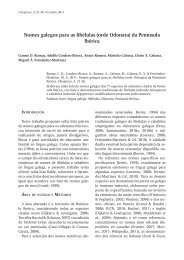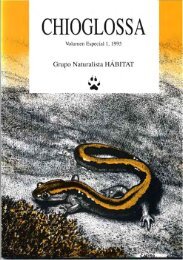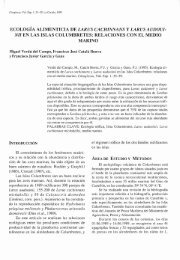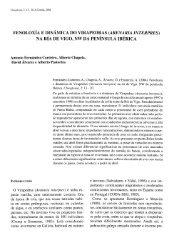1 Tr - Chioglossa
1 Tr - Chioglossa
1 Tr - Chioglossa
You also want an ePaper? Increase the reach of your titles
YUMPU automatically turns print PDFs into web optimized ePapers that Google loves.
I{){)<br />
de que na actualidade soamente resta menos dun<br />
10% do humidal orixinal, non dubidamos que<br />
un ha rexeneración integral permitiría á lagoa de<br />
Cospeito recuperar en breve prazo a importancia<br />
que tivo outrora (véxase. por exemplo, a información<br />
(:ensal en Bernis. 1964, para os anos<br />
1944-64, unha época de caza libre e anárquica).<br />
Así mesmo. a lagoa podería acadar un maior<br />
grao de realización se fose recuperada axeitadamente,<br />
executándose medidas de xestión e<br />
manexo do hábitat coidadosas, tendentes a<br />
incrementar a disponibilidade de recursos tróficos<br />
e a restaurar a diversidade estructural tanto<br />
no que se refire á masa de auga como á vexetación<br />
acuútica.<br />
Agradecementos<br />
A Carmen Lence por suposto. a Luis Costa e de xeito<br />
especial a José A. de Souza. que revisou o orixinal e<br />
realizau non poucas valiosas aportacións.<br />
SUMMARY<br />
The wintaing water:f(¡H'1 community (il the Cospeito<br />
lagoon (Lugo. NW Spain)<br />
The waterfowl on the Cospeito lagoon and wet grasslands<br />
-oOJe of the few natural inland wetlands remaining<br />
in Galicia. even though partially drained- was<br />
regularly censused between September and March<br />
1987-88. 1988-89 and 1989-90, and several parameters<br />
of the community are described in this paper. The<br />
total number of species detected was 29. Peak total<br />
counts ranged from 1,080 to 3,290 birds. Bird numbers<br />
tlucluated widely, maximum abundance and species<br />
richness being reached in the colder months<br />
(December-January). Accordingly. diversity also reached<br />
its :oighest values with the arrival of wintering<br />
wildfowl and waders. Eveness was low to moderately<br />
low and dominance was almost entirely determined<br />
by theMallard.being sometimes outnumbered by<br />
Lapwings in midwinter. The community was largely<br />
made up by omnivorous birds, though herbivorous<br />
and zaoprIagous species almost codominate in midwinter.<br />
Despite the relatively low diversity, the Cospeito<br />
lagoon and surroundings were regionally important<br />
for various waterfowl species and also for the<br />
Little Bu;tard -which shares the grasslands with<br />
CHIOGLOSSA. 1 (1999)<br />
meadow waders- and reached national importance<br />
for Teal. Taking into account that at present it<br />
remains only less than 10% of the former wetland<br />
extent. it is strongly suggested that an appropriate restoration<br />
program should readily give the lagoon back<br />
its former importance as a prime waterfowl habitat.<br />
Key words: community structure. Cospeito lagoon,<br />
waterfowl, wintering.<br />
BIBLIOGRAFÍA<br />
Alegre. J. e Hernández, A. (1989). La comunidad<br />
omítica de la laguna de Santiz (Valdepolo,<br />
León), parámetros ecológicos. Oxyura, 5: 61-82.<br />
Amat, J. A. (1981). Descripción de la comunidad de<br />
patos del Parque Nacional de Doñana. Dol1ana,<br />
Acta Vertebrata, 8: 125-158.<br />
Amat. 1. A. (1984). Las poblaciones de aves acuáticas<br />
en las lagunas andaluzas: composición y diversidad<br />
durante un ciclo annual. Ardeola, 31: 61-79.<br />
Amat, J. A., C. Díaz P., C. M. Herrera, P. Jordano, J.<br />
R. Obeso e R. C. Soriguer (1985). Criterios de<br />
valoración de zonas húmedas de importancia<br />
nacional y regional en júnción de las aves acuáticas.<br />
ICONA Monografías 35, Madrid.<br />
Antúnez, A., Vargas, J. M. e Blasco, M. (1980). Avifauna<br />
de la laguna de Medina (Cádiz). Bol. Est.<br />
CelJtral Ecol., 18: 55-62.<br />
Bárcena. F.. Domínguez, J. e Villarino, A. (1987). El<br />
sisón (Tetrax tetrax) en Galicia (NW de España).<br />
En I Congreso Internacional de Aves Esteparias,<br />
páxs. 163-172. Dirección General de Montes,<br />
Caza, Pesca y Conservación de la Naturaleza,<br />
León.<br />
Bernis, F. (1964). Información española sobre anátidas<br />
y fochas. Publicaciones de la S.E.O. Madrid.<br />
Bibby, C. J., Burgess, N. D. e Hill, D. A. (1992). Bird<br />
Census Techniques. Academic Press, London.<br />
Blondel, J. (1986). Biogeografía y Ecología. Ed. Academia,<br />
León.<br />
Braithwaite, L. W. e Stewart, D. A. (1975). Dynamics<br />
of water bird populations on the Alice Springs<br />
Sewage Farm, N. T. Aus. Wildl. Res., 2: 85-90.<br />
Castro, J. e Castro, X. C. (1990). As lagoas de Cospeito.<br />
Introducción ó estudio dun humidal. Diputación<br />
Provincial de Lugo, Lugo.<br />
Cramp, S. e Simmons, K. E. L. (Eds.) (1977. 1980,<br />
1983). The birds 01 the western Paleartic. Vols.<br />
1, 2 Y3. Oxford University Press. Oxford.








